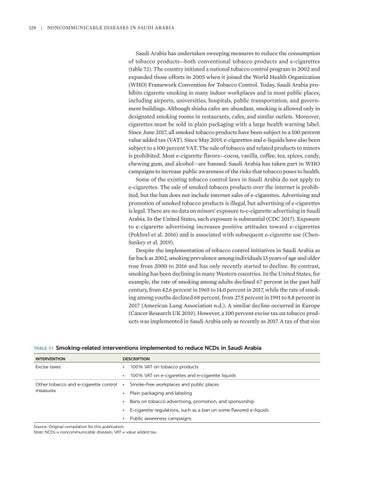128 | Noncommunicable Diseases in Saudi Arabia
Saudi Arabia has undertaken sweeping measures to reduce the consumption of tobacco products—both conventional tobacco products and e-cigarettes (table 7.1). The country initiated a national tobacco control program in 2002 and expanded those efforts in 2005 when it joined the World Health Organization (WHO) Framework Convention for Tobacco Control. Today, Saudi Arabia prohibits cigarette smoking in many indoor workplaces and in most public places, including airports, universities, hospitals, public transportation, and government buildings. Although shisha cafes are abundant, smoking is allowed only in designated smoking rooms in restaurants, cafes, and similar outlets. Moreover, cigarettes must be sold in plain packaging with a large health warning label. Since June 2017, all smoked tobacco products have been subject to a 100 percent value added tax (VAT). Since May 2019, e-cigarettes and e-liquids have also been subject to a 100 percent VAT. The sale of tobacco and related products to minors is prohibited. Most e-cigarette flavors—cocoa, vanilla, coffee, tea, spices, candy, chewing gum, and alcohol—are banned. Saudi Arabia has taken part in WHO campaigns to increase public awareness of the risks that tobacco poses to health. Some of the existing tobacco control laws in Saudi Arabia do not apply to e-cigarettes. The sale of smoked tobacco products over the internet is prohibited, but the ban does not include internet sales of e-cigarettes. Advertising and promotion of smoked tobacco products is illegal, but advertising of e-cigarettes is legal. There are no data on minors’ exposure to e-cigarette advertising in Saudi Arabia. In the United States, such exposure is substantial (CDC 2017). Exposure to e-cigarette advertising increases positive attitudes toward e-cigarettes (Pokhrel et al. 2016) and is associated with subsequent e-cigarette use (ChenSankey et al. 2019). Despite the implementation of tobacco control initiatives in Saudi Arabia as far back as 2002, smoking prevalence among individuals 15 years of age and older rose from 2000 to 2016 and has only recently started to decline. By contrast, smoking has been declining in many Western countries. In the United States, for example, the rate of smoking among adults declined 67 percent in the past half century, from 42.6 percent in 1965 to 14.0 percent in 2017, while the rate of smoking among youths declined 68 percent, from 27.5 percent in 1991 to 8.8 percent in 2017 (American Lung Association n.d.). A similar decline occurred in Europe (Cancer Research UK 2019). However, a 100 percent excise tax on tobacco products was implemented in Saudi Arabia only as recently as 2017. A tax of that size
TABLE 7.1 Smoking-related
interventions implemented to reduce NCDs in Saudi Arabia
INTERVENTION
DESCRIPTION
Excise taxes
• 100% VAT on tobacco products • 100% VAT on e-cigarettes and e-cigarette liquids
Other tobacco and e-cigarette control measures
• Smoke-free workplaces and public places • Plain packaging and labeling • Bans on tobacco advertising, promotion, and sponsorship • E-cigarette regulations, such as a ban on some flavored e-liquids • Public awareness campaigns
Source: Original compilation for this publication. Note: NCDs = noncommunicable diseases. VAT = value added tax.

